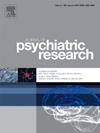Enterobacterial caseinolytic protease B (ClpB) and ClpB antibodies in adolescents with anorexia nervosa
IF 3.7
2区 医学
Q1 PSYCHIATRY
引用次数: 0
Abstract
Caseinolytic protease B (ClpB) produced by the gut enterobacteria displays anorexigenic effects possibly due to its molecular mimicry with α-melanocyte-stimulating hormone (α-MSH), an anorexigenic neuropeptide. ClpB is known to induce α-MSH cross-reactive antibodies previously associated with eating disorders. In the present study we analyzed whether long-term changes of serum ClpB, anti-ClpB antibodies and fecal clpB gene content can be associated with disease progression in anorexia nervosa (AN). For this purpose, female adolescents diagnosed with the restrictive type of AN according to DSM-5 were studied at hospital admission, discharge, and at a 1-year follow up visit, while age-matched healthy female participants served as a control group. We found that ClpB protein was detected at variable levels in sera of all study participants without significant group differences. However, anti-ClpB IgG were low in adolescents with AN at the acute phase of disease and were characterized by increased affinity. Long-term individual dynamics of serum ClpB revealed that its increase after hospital discharge was associated with disease relapse. In healthy adolescents, serum ClpB correlated negatively with BMI-SDS. Fecal clpB DNA levels were low in patients at hospital admission and discharge correlating positively with the abundance of Enterobacteriaceae in gut microbiota. Thus, in healthy adolescents enterobacterial ClpB appears as a physiological microbiota-derived factor associated with lower body weight within the normal range. Low levels of anti-ClpB IgG in adolescents with AN may cause insufficient immune control of ClpB, possibly promoting ClpB anorexigenic effects which can be relevant to the pathophysiology of AN.

求助全文
约1分钟内获得全文
求助全文
来源期刊

Journal of psychiatric research
医学-精神病学
CiteScore
7.30
自引率
2.10%
发文量
622
审稿时长
130 days
期刊介绍:
Founded in 1961 to report on the latest work in psychiatry and cognate disciplines, the Journal of Psychiatric Research is dedicated to innovative and timely studies of four important areas of research:
(1) clinical studies of all disciplines relating to psychiatric illness, as well as normal human behaviour, including biochemical, physiological, genetic, environmental, social, psychological and epidemiological factors;
(2) basic studies pertaining to psychiatry in such fields as neuropsychopharmacology, neuroendocrinology, electrophysiology, genetics, experimental psychology and epidemiology;
(3) the growing application of clinical laboratory techniques in psychiatry, including imagery and spectroscopy of the brain, molecular biology and computer sciences;
 求助内容:
求助内容: 应助结果提醒方式:
应助结果提醒方式:


